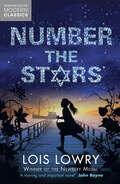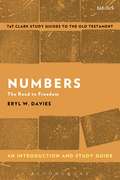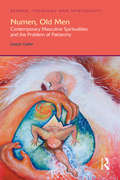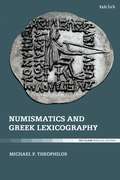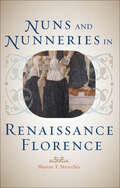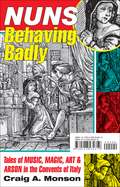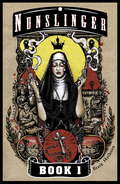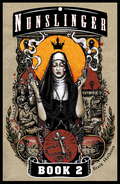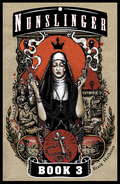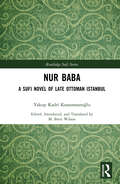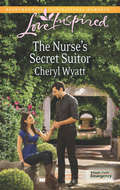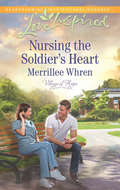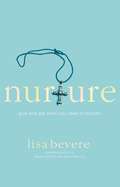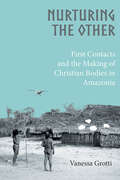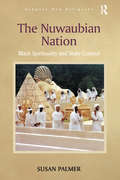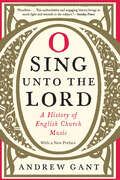- Table View
- List View
Number the Stars (Collins Modern Classics Ser.)
by Lois LowryA powerful story set in Nazi occupied Denmark in 1943. Ten-year-old Annemarie Johansen is called upon for a selfless act of bravery to help save her best-friend, Ellen – a Jew.
Numbers: The Road to Freedom (T&T Clark’s Study Guides to the Old Testament)
by Eryl W. DaviesDavies outlines the composition and date of Numbers, and the various attempts that have been made to establish a coherent and meaningful structure in its arrangement. Davies also shows how the application of reader-response criticism, feminist criticism and postcolonial criticism have contributed to our understanding of selected passages in the book. Addressing theological issues, Davies considers three themes that occupy much of the content of Numbers, namely; land, purity and holiness, and rebellion. The concluding chapter considers the contentious issue of the historicity of the book of Numbers in the light of recent discussions concerning the historical value of the Old Testament. Davies shows how some of the issues Numbers raises – war, disease, survival, hunger, race relations – are among the perennial problems faced by nations across the centuries and across cultures. While individual passages within Numbers may reflect a questionable sense of morality, Davies demonstrates that the book, when viewed in its totality, encompasses a number of important theological themes which recur throughout the Old Testament: the interplay of forgiveness and judgment, and of sin and punishment, and the need to trust in the power of God rather than human might.
Numbers: The Road to Freedom (T&T Clark’s Study Guides to the Old Testament)
by Eryl W. DaviesDavies outlines the composition and date of Numbers, and the various attempts that have been made to establish a coherent and meaningful structure in its arrangement. Davies also shows how the application of reader-response criticism, feminist criticism and postcolonial criticism have contributed to our understanding of selected passages in the book. Addressing theological issues, Davies considers three themes that occupy much of the content of Numbers, namely; land, purity and holiness, and rebellion. The concluding chapter considers the contentious issue of the historicity of the book of Numbers in the light of recent discussions concerning the historical value of the Old Testament. Davies shows how some of the issues Numbers raises – war, disease, survival, hunger, race relations – are among the perennial problems faced by nations across the centuries and across cultures. While individual passages within Numbers may reflect a questionable sense of morality, Davies demonstrates that the book, when viewed in its totality, encompasses a number of important theological themes which recur throughout the Old Testament: the interplay of forgiveness and judgment, and of sin and punishment, and the need to trust in the power of God rather than human might.
Numen, Old Men: Contemporary Masculine Spiritualities and the Problem of Patriarchy (Gender, Theology and Spirituality)
by Joseph GelferSince the early 1990s there have been various movements designed to encourage 'masculine spirituality'. All these movements share a concern that spirituality has become too feminine and that men's experiences of the spiritual are being marginalized. The task of masculine spirituality is to promote 'authentic' masculine characteristics within a spiritual context. Numen, Old Men examines these characteristics to argue that masculine spirituality is thinly veiled patriarchy. The mythopoetic, evangelical, and Catholic men's movements are shown to promote a hetero-patriarchal spirituality by appealing to either combative and oppressive neo-Jungian archetypes or biblical models of man as the leader of the family. Numen, Old Men examines spiritualities that aim to honour and transcend both the masculine and feminine, and offers gay spirituality as an example of masculine spirituality that resists patriarchy.
Numen, Old Men: Contemporary Masculine Spiritualities and the Problem of Patriarchy (Gender, Theology and Spirituality)
by Joseph GelferSince the early 1990s there have been various movements designed to encourage 'masculine spirituality'. All these movements share a concern that spirituality has become too feminine and that men's experiences of the spiritual are being marginalized. The task of masculine spirituality is to promote 'authentic' masculine characteristics within a spiritual context. Numen, Old Men examines these characteristics to argue that masculine spirituality is thinly veiled patriarchy. The mythopoetic, evangelical, and Catholic men's movements are shown to promote a hetero-patriarchal spirituality by appealing to either combative and oppressive neo-Jungian archetypes or biblical models of man as the leader of the family. Numen, Old Men examines spiritualities that aim to honour and transcend both the masculine and feminine, and offers gay spirituality as an example of masculine spirituality that resists patriarchy.
Numismatics and Greek Lexicography
by Michael P. TheophilosMichael P. Theophilos explores the fascinating variety of numismatic contributions to Greek lexicography, pertaining to lexicographic studies of the Second Temple period in general, and the New Testament in particular. Theophilos considers previous scholarly attempts to grapple with, and incorporate, critical numismatic material into the emerging discipline of Greek lexicography - including foundational work by F. Preisigke and E. Kiessling - before outlining his own methodological approach. Theophilos' then examines the resources available for engaging with the numismatic material, and presents a series of specific case studies throughout the New Testament material. His carefully annotated images of coins draw readers in to a greater understanding of the material culture of the Greco-Roman world, and how this impacted upon the Greek language and the New Testament.
Numismatics and Greek Lexicography
by Michael P. TheophilosMichael P. Theophilos explores the fascinating variety of numismatic contributions to Greek lexicography, pertaining to lexicographic studies of the Second Temple period in general, and the New Testament in particular. Theophilos considers previous scholarly attempts to grapple with, and incorporate, critical numismatic material into the emerging discipline of Greek lexicography - including foundational work by F. Preisigke and E. Kiessling - before outlining his own methodological approach. Theophilos' then examines the resources available for engaging with the numismatic material, and presents a series of specific case studies throughout the New Testament material. His carefully annotated images of coins draw readers in to a greater understanding of the material culture of the Greco-Roman world, and how this impacted upon the Greek language and the New Testament.
Nuns and Nunneries in Renaissance Florence
by Sharon T. StrocchiaThe 15th century was a time of dramatic and decisive change for nuns and nunneries in Florence. In the course of that century, the city’s convents evolved from small, semiautonomous communities to large civic institutions. By 1552, roughly one in eight Florentine women lived in a religious community. Historian Sharon T. Strocchia analyzes this stunning growth of female monasticism, revealing the important roles these women and institutions played in the social, economic, and political history of Renaissance Florence. It became common practice during this time for unmarried women in elite society to enter convents. This unprecedented concentration of highly educated and well-connected women transformed convents into sites of great patronage and social and political influence. As their economic influence also grew, convents found new ways of supporting themselves; they established schools, produced manuscripts, and manufactured textiles. Strocchia has mined previously untapped archival materials to uncover how convents shaped one of the principal cities of Renaissance Europe. She demonstrates the importance of nuns and nunneries to the booming Florentine textile industry and shows the contributions that ordinary nuns made to Florentine life in their roles as scribes, stewards, artisans, teachers, and community leaders. In doing so, Strocchia argues that the ideals and institutions that defined Florence were influenced in great part by the city’s powerful female monastics. Nuns and Nunneries in Renaissance Florence shows for the first time how religious women effected broad historical change and helped write the grand narrative of medieval and Renaissance Europe. The book is a valuable text for students and scholars in early modern European history, religion, women’s studies, and economic history.
Nuns Behaving Badly: Tales of Music, Magic, Art, and Arson in the Convents of Italy
by Craig A. MonsonWitchcraft. Arson. Going AWOL. Some nuns in sixteenth- and seventeenth-century Italy strayed far from the paradigms of monastic life. Cloistered in convents, subjected to stifling hierarchy, repressed, and occasionally persecuted by their male superiors, these women circumvented authority in sometimes extraordinary ways. But tales of their transgressions have long been buried in the Vatican Secret Archive. That is, until now. In Nuns Behaving Badly, Craig A. Monson resurrects forgotten tales and restores to life the long-silent voices of these cloistered heroines. Here we meet nuns who dared speak out about physical assault and sexual impropriety (some real, some imagined). Others were only guilty of misjudgment or defacing valuable artwork that offended their sensibilities. But what unites the women and their stories is the challenges they faced: these were women trying to find their way within the Catholicism of their day and through the strict limits it imposed on them. Monson introduces us to women who were occasionally desperate to flee cloistered life, as when an entire community conspired to torch their convent and be set free. But more often, he shows us nuns just trying to live their lives. When they were crossed—by powerful priests who claimed to know what was best for them—bad behavior could escalate from mere troublemaking to open confrontation. In resurrecting these long-forgotten tales and trials, Monson also draws attention to the predicament of modern religious women, whose “misbehavior”—seeking ordination as priests or refusing to give up their endowments to pay for priestly wrongdoing in their own archdioceses—continues even today. The nuns of early modern Italy, Monson shows, set the standard for religious transgression in their own age—and beyond.
Nunslinger 1 (Nunslinger #1)
by Stark HolbornThe year is 1864. Sister Thomas Josephine is on her way from St Louis, Missouri, to Sacramento, California. During the course of her journey, however, she'll find that her faith requires her to take off her wimple and pick up a gun. Innocent Visitandine nun Sister Thomas Josephine wants nothing more than an adventure-free journey out west. But adventure is what she'll get - and heaps of it - when she's taken hostage by a desperate outlaw on the Laramie Plains of Wyoming. Before long she'll find herself torn between two men, the handsome Union Army Lieutentant Thomas F. Carthy and the mysterious drifter Abraham C. Muir. And soon, one of these men will be staring down the barrel of her gun. In this exclusive, free, all-new ebook, you’ll meet Sister Thomas Josephine, the innocent Visitandine nun, and travel along the overland trail with her as she meets varmints and scallywaygs galore. Free for a very limited time only, Nunslinger Book 1 is the first in an extraordinary new series that will publish serially throughout 2014. Don’t miss a single instalment – preorder Sister Thomas Josephine’s adventures today!
Nunslinger 2: The Good, the Bad and the Penitent (Nunslinger #2)
by Stark HolbornThe year is 1864. Sister Thomas Josephine is on her way from St Louis, Missouri, to Sacramento, California. During the course of her journey, however, she'll find that her faith requires her to take off her wimple and pick up a gun...NUNSLINGER Book II relates the true tale of how Sister Thomas Josephine of St Louis, Missouri, comes to be wanted for murder and faces the hangman's noose in Carson City, Nevada. Only by relying on the help of an armload of fancy women and a wily old friend does she have any hope for escape!
Nunslinger 3: A Pilgrim and a Stranger (Nunslinger #3)
by Stark HolbornThe year is 1864. Sister Thomas Josephine is on her way from St Louis, Missouri, to Sacramento, California. During the course of her journey, however, she'll find that her faith requires her to take off her wimple and pick up a gun...NUNSLINGER Book III finds Sister Thomas Josephine, now a fugitive from the law, racing through the harsh Sierra Nevada winter for the Mexican border. Hard on her heels is an old enemy... with a grudge the size of Texas. And she knows that if the cold doesn't kill her, he will.
Nur Baba: A Sufi Novel of Late Ottoman Istanbul (Routledge Sufi Series)
by Yakup Kadri KaraosmanoğluThis first-ever English translation of Nur Baba – a classic of modern Turkish literature written by Yakup Kadri Karaosmanoğlu – offers a unique window into Sufi lodges, social dilemmas, and intellectual life in early twentieth-century Istanbul. Inspired by Karaosmanoğlu’s personal experiences with Islamic mystical orders, it is a story of illicit romance and spiritual inquiry, depicting a colourful lodge of Sufi dervishes led by a charismatic, yet morally suspect, spiritual master named Nur Baba. The plot follows his attempts to seduce an attractive married woman from an elite family and recounts her dramatic experiences in the life of a Sufi community. The setting shuttles between the grand mansions of Istanbul’s elite families and a Sufi lodge where rich and poor intermingle. Exploring questions of gender, morality, and religious bias throughout, it captures the zeitgeist of early twentieth-century modernist thinkers who criticised Sufism for impeding social progress and debated the public roles of women in a rapidly modernising society. Alongside the editor’s meticulous translation, the volume includes a scholarly introduction, maps, and images, as well as explanatory footnotes that will aid both students and scholars alike. The novel will be of particular interest to those studying world literature, Sufi studies, and Ottoman-Turkish history.
Nur Baba: A Sufi Novel of Late Ottoman Istanbul (Routledge Sufi Series)
by Yakup Kadri KaraosmanoğluThis first-ever English translation of Nur Baba – a classic of modern Turkish literature written by Yakup Kadri Karaosmanoğlu – offers a unique window into Sufi lodges, social dilemmas, and intellectual life in early twentieth-century Istanbul. Inspired by Karaosmanoğlu’s personal experiences with Islamic mystical orders, it is a story of illicit romance and spiritual inquiry, depicting a colourful lodge of Sufi dervishes led by a charismatic, yet morally suspect, spiritual master named Nur Baba. The plot follows his attempts to seduce an attractive married woman from an elite family and recounts her dramatic experiences in the life of a Sufi community. The setting shuttles between the grand mansions of Istanbul’s elite families and a Sufi lodge where rich and poor intermingle. Exploring questions of gender, morality, and religious bias throughout, it captures the zeitgeist of early twentieth-century modernist thinkers who criticised Sufism for impeding social progress and debated the public roles of women in a rapidly modernising society. Alongside the editor’s meticulous translation, the volume includes a scholarly introduction, maps, and images, as well as explanatory footnotes that will aid both students and scholars alike. The novel will be of particular interest to those studying world literature, Sufi studies, and Ottoman-Turkish history.
The Nurse's Secret Suitor: White Christmas In Dry Creek The Nurse's Secret Suitor Lone Star Holiday (Eagle Point Emergency #3)
by Cheryl WyattTrauma nurse Kate Dalton can handle any challenge—except love. The combat veteran dreams of settling down, but heartbreak is one risk she won’t take. Then a chance encounter opens her heart to a masked stranger…
Nursing the Soldier's Heart: The Cowboy's Surprise Baby Family Wanted Nursing The Soldier's Heart (Village of Hope #2)
by Merrillee WhrenLoving the Soldier
Nurture: Give and Get What You Need to Flourish
by Lisa BevereNurture (verb): 1. To give tender care and protection. 2. To encourage to grow, develop, thrive, and be successful.This beautifully describes what God's daughters so desperately need. In this heartfelt work, Lisa explains how women of all ages must awaken and restore their capacity to give and receive nurture. The need for this indelible force is far more urgent than we know. Is it possible we are too busy surviving to assure that the vulnerable among us thrive? Are we too guarded, wounded, and afraid to open our lives to the nurture of others? What can be done to reestablish this language of the feminine heart? It is time women are healed and empowered. If you have never experienced nurture, this is your season. Lisa's stirring message shows you how to make these vital heart connections. We need each other's comfort and assurance as we define ourselves, find our voice, and begin to fulfill God's purpose on Earth. In Lisa's own words: "There is such a resonance in my spirit . . . this is in fact our season to grow, develop, and thrive. Heaven is passionately and purposefully reconnecting with our wounded, war-torn earth and the people who inhabit her. In this season I believe the daughters of God will prove integral agents. Nurture is not expensive-it is expansive. The life of everyone enlarges when it is added. As this happens, we will cease to merely function-we will indeed flourish."
Nurturing the Other: First Contacts and the Making of Christian Bodies in Amazonia
by Vanessa GrottiCombining archival research, oral history and long-term ethnography, this book studies relations between Amerindians and outsiders, such as American missionaries, through a series of contact expeditions that led to the 'pacification' of three native Amazonian groups in Suriname and French Guiana. The author examines and contrasts Amerindian and non-Amerindian views on this process of social transformation through the lens of the body, notions of peacefulness and kinship, as well as native warfare and shamanism. The book addresses questions of change and continuity, and the little explored links between first contacts, capture and native conversion to Christianity in contemporary indigenous Amazonia.
Nurturing the Other: First Contacts and the Making of Christian Bodies in Amazonia
by Vanessa GrottiCombining archival research, oral history and long-term ethnography, this book studies relations between Amerindians and outsiders, such as American missionaries, through a series of contact expeditions that led to the 'pacification' of three native Amazonian groups in Suriname and French Guiana. The author examines and contrasts Amerindian and non-Amerindian views on this process of social transformation through the lens of the body, notions of peacefulness and kinship, as well as native warfare and shamanism. The book addresses questions of change and continuity, and the little explored links between first contacts, capture and native conversion to Christianity in contemporary indigenous Amazonia.
The Nuwaubian Nation: Black Spirituality and State Control (Routledge New Religions)
by Susan PalmerThe Nuwaubian Nation takes the reader on a journey into an African-American spiritual movement. The United Nuwaubian Nation has changed shape since its inceptions in the 1970s, transforming from a Black Hebrew mystery school into a Muslim utopian community in Brooklyn, N.Y.; from an Egyptian theme park into an Amerindian reserve in rural Georgia. This book follows the extraordinary career of Dwight York, who in his teens started out in a New York street gang, but converted to Islam in prison. Emerging as a Black messiah, York proceeded to break the Paleman’s spell of Kingu and to guide his people through a series of racial/religious identities that demanded dramatic changes in costume, gender roles and lifestyle. Dr. York’s Blackosophy is analyzed as a new expression of that ancient mystical worldview, Gnosticism. Referring to theories in the sociology of deviance and media studies, the author tracks the escalating hostilities against the group that climaxed in a Waco-style FBI raid on the Nuwaubian compound in 2002. In the ensuing legal process we witness Dr. York’s dramatic reversals of fortune; he is now serving a 135-year sentence as his Black Panther lawyer prepares to take his case to the Supreme Court. This book presents fresh and important insights into racialist spirituality and the social control of unconventional religions in America.
The Nuwaubian Nation: Black Spirituality and State Control (Routledge New Religions)
by Susan PalmerThe Nuwaubian Nation takes the reader on a journey into an African-American spiritual movement. The United Nuwaubian Nation has changed shape since its inceptions in the 1970s, transforming from a Black Hebrew mystery school into a Muslim utopian community in Brooklyn, N.Y.; from an Egyptian theme park into an Amerindian reserve in rural Georgia. This book follows the extraordinary career of Dwight York, who in his teens started out in a New York street gang, but converted to Islam in prison. Emerging as a Black messiah, York proceeded to break the Paleman’s spell of Kingu and to guide his people through a series of racial/religious identities that demanded dramatic changes in costume, gender roles and lifestyle. Dr. York’s Blackosophy is analyzed as a new expression of that ancient mystical worldview, Gnosticism. Referring to theories in the sociology of deviance and media studies, the author tracks the escalating hostilities against the group that climaxed in a Waco-style FBI raid on the Nuwaubian compound in 2002. In the ensuing legal process we witness Dr. York’s dramatic reversals of fortune; he is now serving a 135-year sentence as his Black Panther lawyer prepares to take his case to the Supreme Court. This book presents fresh and important insights into racialist spirituality and the social control of unconventional religions in America.
O Sing unto the Lord: A History of English Church Music
by Andrew GantFor as long as people have worshipped together, music has played a key role in church life. With O Sing unto the Lord, Andrew Gant offers a fascinating history of English church music, from the Latin chant of late antiquity to the great proliferation of styles seen in contemporary repertoires. The ornate complexity of pre-Reformation Catholic liturgies revealed the exclusive nature of this form of worship. By contrast, simple English psalms, set to well-known folk songs, summed up the aims of the Reformation with its music for everyone. The Enlightenment brought hymns, the Methodists and Victorians a new delight in the beauty and emotion of worship. Today, church music mirrors our multifaceted worldview, embracing the sounds of pop and jazz along with the more traditional music of choir and organ. And reflecting its truly global reach, the influence of English church music can be found in everything from masses sung in Korean to American Sacred Harp singing. From medieval chorales to “Amazing Grace,” West Gallery music to Christmas carols, English church music has broken through the boundaries of time, place, and denomination to remain familiar and cherished everywhere. Expansive and sure to appeal to all music lovers, O Sing unto the Lord is the biography of a tradition, a book about people, and a celebration of one of the most important sides to our cultural heritage.
O Sing unto the Lord: A History of English Church Music
by Andrew GantFor as long as people have worshipped together, music has played a key role in church life. With O Sing unto the Lord, Andrew Gant offers a fascinating history of English church music, from the Latin chant of late antiquity to the great proliferation of styles seen in contemporary repertoires. The ornate complexity of pre-Reformation Catholic liturgies revealed the exclusive nature of this form of worship. By contrast, simple English psalms, set to well-known folk songs, summed up the aims of the Reformation with its music for everyone. The Enlightenment brought hymns, the Methodists and Victorians a new delight in the beauty and emotion of worship. Today, church music mirrors our multifaceted worldview, embracing the sounds of pop and jazz along with the more traditional music of choir and organ. And reflecting its truly global reach, the influence of English church music can be found in everything from masses sung in Korean to American Sacred Harp singing. From medieval chorales to “Amazing Grace,” West Gallery music to Christmas carols, English church music has broken through the boundaries of time, place, and denomination to remain familiar and cherished everywhere. Expansive and sure to appeal to all music lovers, O Sing unto the Lord is the biography of a tradition, a book about people, and a celebration of one of the most important sides to our cultural heritage.
O Sing unto the Lord: A History of English Church Music
by Andrew GantFor as long as people have worshipped together, music has played a key role in church life. With O Sing unto the Lord, Andrew Gant offers a fascinating history of English church music, from the Latin chant of late antiquity to the great proliferation of styles seen in contemporary repertoires. The ornate complexity of pre-Reformation Catholic liturgies revealed the exclusive nature of this form of worship. By contrast, simple English psalms, set to well-known folk songs, summed up the aims of the Reformation with its music for everyone. The Enlightenment brought hymns, the Methodists and Victorians a new delight in the beauty and emotion of worship. Today, church music mirrors our multifaceted worldview, embracing the sounds of pop and jazz along with the more traditional music of choir and organ. And reflecting its truly global reach, the influence of English church music can be found in everything from masses sung in Korean to American Sacred Harp singing. From medieval chorales to “Amazing Grace,” West Gallery music to Christmas carols, English church music has broken through the boundaries of time, place, and denomination to remain familiar and cherished everywhere. Expansive and sure to appeal to all music lovers, O Sing unto the Lord is the biography of a tradition, a book about people, and a celebration of one of the most important sides to our cultural heritage.
O Sing unto the Lord: A History of English Church Music
by Andrew GantFor as long as people have worshipped together, music has played a key role in church life. With O Sing unto the Lord, Andrew Gant offers a fascinating history of English church music, from the Latin chant of late antiquity to the great proliferation of styles seen in contemporary repertoires. The ornate complexity of pre-Reformation Catholic liturgies revealed the exclusive nature of this form of worship. By contrast, simple English psalms, set to well-known folk songs, summed up the aims of the Reformation with its music for everyone. The Enlightenment brought hymns, the Methodists and Victorians a new delight in the beauty and emotion of worship. Today, church music mirrors our multifaceted worldview, embracing the sounds of pop and jazz along with the more traditional music of choir and organ. And reflecting its truly global reach, the influence of English church music can be found in everything from masses sung in Korean to American Sacred Harp singing. From medieval chorales to “Amazing Grace,” West Gallery music to Christmas carols, English church music has broken through the boundaries of time, place, and denomination to remain familiar and cherished everywhere. Expansive and sure to appeal to all music lovers, O Sing unto the Lord is the biography of a tradition, a book about people, and a celebration of one of the most important sides to our cultural heritage.
